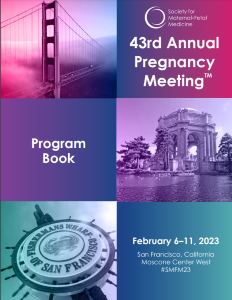Category: Neonatology
Poster Session I
(249) Late preterm polyhydramnios and the risk of transient tachypnea of the newborn
Clearance of fetal lung fluid at birth is instrumental in neonatal respiratory outcomes, with decreased fluid clearance related to development of transient tachypnea of the newborn (TTN). The effects of excess fetal lung fluid on neonatal respiratory outcomes in the late preterm (LP) period have yet to be elucidated. We aimed to determine if polyhydramnios (POLY) in LP gestation increases the risk of TTN.
Study Design:
This is a secondary analysis of prospectively collected data from a multi-center clinical trial. Subjects with singleton pregnancies from 34 to 36 weeks gestation with documented amniotic fluid either by maximum vertical pocket (MVP) or amniotic fluid index (AFI) were included. Those with oligohydramnios or congenital malformations were excluded. Polyhydramnios, the exposure, was defined as MVP > 8 cm or AFI > 24 cm. The primary outcome, TTN, was compared between POLY and normal fluid (MVP ≥ 2cm and ≤ 8cm or AFI ≥ 5 cm and ≤ 24 cm) groups. Secondary outcomes included the use of respiratory support such as oxygen, continuous positive airway pressure (CPAP), or mechanical ventilation (MV), a composite of these, and selected neonatal outcomes. Students’ t-test, Wilcoxon rank sum, and chi square analyses were performed, as appropriate. We fit logistic regression models to adjust for differences in exposure present at baseline.
Results:
2689 subjects were included for analysis (29 POLY, 2660 normal fluid) (Table 1). In the unadjusted model, TTN rates were similar in the POLY and normal fluid groups. The need for CPAP, high flow nasal cannula or oxygen support was not different between the groups, although MV was more common in the POLY group (P=.01, OR 4.2, 95% CI 1.2-14.2). After adjusting for clinically relevant or statistically different variables at baseline, POLY was an independent risk factor for TTN (P=.04, OR 2.9, 95% CI 1.0-7.5) and mechanical ventilation (P=.02, OR 4.6, 95% CI 1.3-16.1) (Table 2).
Conclusion:
Polyhydramnios is an independent risk factor for TTN in the LP period. Special postnatal attention should be given to neonates born from this environment.
.jpg)
Lauryn C. Gabby, MD
Maternal Fetal Medicine Fellow
University of California, San Diego
San Diego, California, United States- JK
Jenny B. Koenig, MD, PhD
University of California, San Diego
La Jolla, California, United States 
Dana R. Canfield, MD
Maternal Fetal Medicine Fellow
University of California, San Diego
La Jolla, California, United States
Jerasimos Ballas, MD, MPH (he/him/his)
Associate Clinical Professor
UC San Diego Health
La Jolla, California, United States
Cynthia Gyamfi-Bannerman, MD, MS (she/her/hers)
Professor and Chair
University of California San Diego
La Jolla, California, United States

.png)
